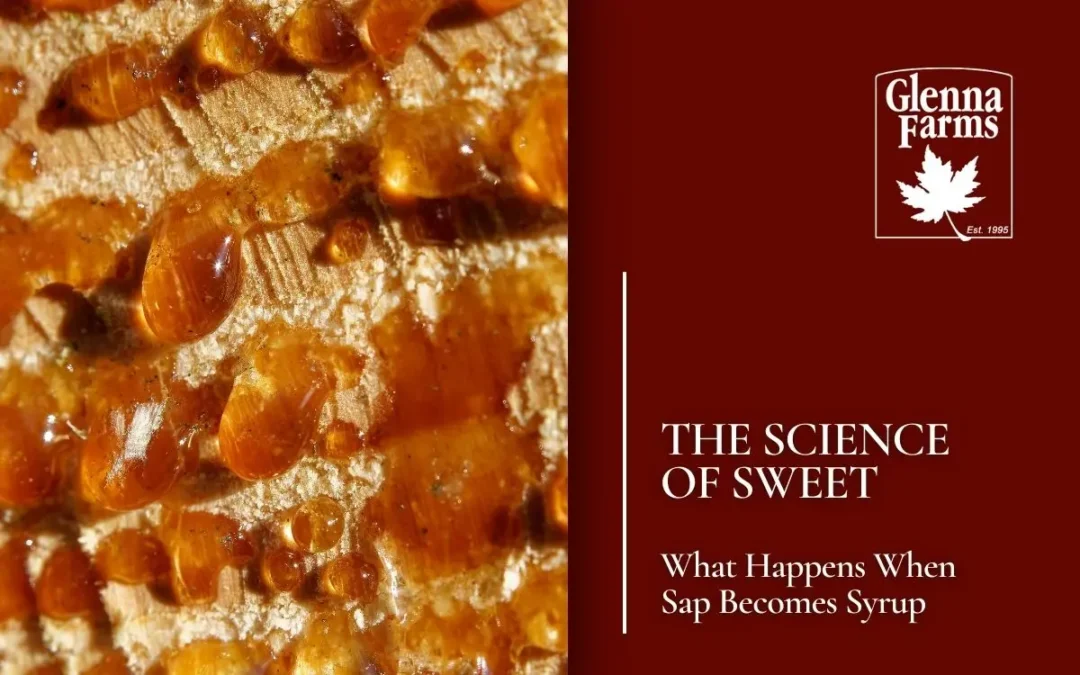The Science of Sweet: What Happens When Sap Becomes Syrup
As you pour maple syrup over a hot stack of pancakes, you savor one of nature’s sweetest indulgences. But have you ever stopped to think about how that golden elixir journeys from tree to table? The process isn’t solely about tradition or science. Glenna Farms uses old-fashioned methods and nature’s chemistry to create pure, local, and delicious syrup.
Here on this blog, we will share the science behind what occurs when clear sap from a maple tree is transformed into the tasty, rich syrup you love.
Where It All Begins: The Maple Tree
Maple syrup starts in the middle of Wisconsin’s maple woodlots, in early spring, with chilly nights and warming days, maple trees begin to “awaken” from winter. This unique freeze-thaw process is what causes sap to run.
Cold nights induce pressure inside the tree, pulling water and nutrients from the roots.
Warm days release that pressure, causing sap to drain from small taps on the trunk.
It looks and tastes almost identical to water. It’s clear, sweet, and loaded with natural sugars, minerals, and nutrients. But at this raw stage, it has only 2% sugar. A lot of science (and boiling!) is needed to bring it to syrup consistency.
The Magic Number: 40 to 1
One interesting tidbit is that it takes about 40 gallons of sap to make one gallon of maple syrup. Why, you wonder? Sap is mostly water; to concentrate all those sugars, we must drive off nearly all that water.
That’s where Glenna Farms’ sugarhouse enters the picture. Buckets of sap are brought into large evaporators, where heat slowly boils the sap down into syrup.
Boiling: Where Science Happens
During boiling, water becomes steam, and the sugar inside becomes denser. Boiling thickens liquids and unleashes new flavors.
- Caramelization: As sugar heats, it caramelizes, producing syrup with a deep, rich golden color and warm, rich flavor.
- Compound flavors: In addition to sweetness, boiling releases natural vanilla and toffee flavors and even a hint of smokiness.
- Nutrient content: Minerals like manganese, zinc, and potassium become more accessible in the finishing syrup, making maple syrup less processed than natural sugar.
This delicate balance of temperature and timing distinguishes small-batch syrup like ours. Boil it too long, and the sap burns. Not long enough, and it doesn’t properly thicken into syrup. At Glenna Farms, we’ve got the process down pat after years of hands-on experimentation and more than a few science-backed tricks of the trade.
Grading Syrup: Why Color and Taste Change
Maple syrup doesn’t always taste or look the same. Did you know that some are light golden and others are dark amber? That’s due to when the sap was tapped and how the sugars matured over the season.
- Golden syrup: Tapped early in the season. It tastes light and gentle.
- Amber syrup: Tapped mid-season with an even, silky flavor.
- Dark syrup: This is made towards the end of the season. It’s strong, full-bodied, and great for cooking.
This system is one of natural chemistry. Sap gets more sugar content and more decadent flavors the farther through the season it is. It’s the tree’s process for getting ready for spring growth, and our process for enjoying varying syrup styles.
Why Maple Syrup Is Different from Processed Sugar
The chemistry of maple syrup also explains why it’s healthier than factory-processed sugar. Factory-processed sugar contains no nutrients during processing. Maple syrup does contain minute traces of natural minerals and a lower glycemic index. That is, it raises blood sugar levels more slowly, which prevents energy crashes.
In addition, its strong flavor requires you to use less to satisfy your appetite. A touch of drizzle does the trick!
Fun Science Fact: Syrup Density
So we know it’s officially syrup. How then? Science, once more! Real maple syrup is about 66% sugar by density. To check it out, syrup makers use a hydrometer, a tool that measures the liquid’s thickness. Too thin, and it’s sweet water. Too thick, and it becomes crystallized in the bottle. Getting that sweet spot just right makes every bottle of Glenna Farms syrup silky smooth, pourable, and delicious.
The Sweet Tradition of Science
While the process may be scientific, it’s also exceedingly traditional. Wisconsin families have been making maple syrup for generations based on land knowledge and sap science. We at Glenna Farms are proud to continue the tradition, tapping trees, boiling sap, and bottling syrup with love.
Each season, our sugarhouse is full of steam, sugary aromas, and the joy of transforming nature’s gift into something truly extraordinary. People will visit to witness the process, and it feels like entering a science laboratory powered by tradition and love.
Bringing Science to Your Table
The next time you pour maple syrup, remember the science behind each drop:
- The freeze-thaw cycle that gets sap flowing.
- The caramelizing boiling that creates sugar flavor.
- The wise grading gives you light, amber, or dark syrup.
- The precise density that defines genuine syrup.
- It’s not a topping—it’s the result of the combination of nature’s chemistry and man’s technology.
Final Thoughts
Maple syrup can appear easy, but each bottle has an incredible story of science and heritage behind it. From tree roots drawing in nutrients to the precise boiling that releases caramel flavors, each step counts.
At Glenna Farms, we respect the science and art of syrup production and ensure that what ends up on your plate is pure, natural, and tasty.
So, the next time you drizzle maple syrup on pancakes, oatmeal, or roasted vegetables, you can enjoy more than just the taste; you can enjoy the story of sap to syrup.
Pure. Local. Delicious. That’s Glenna Farms.

